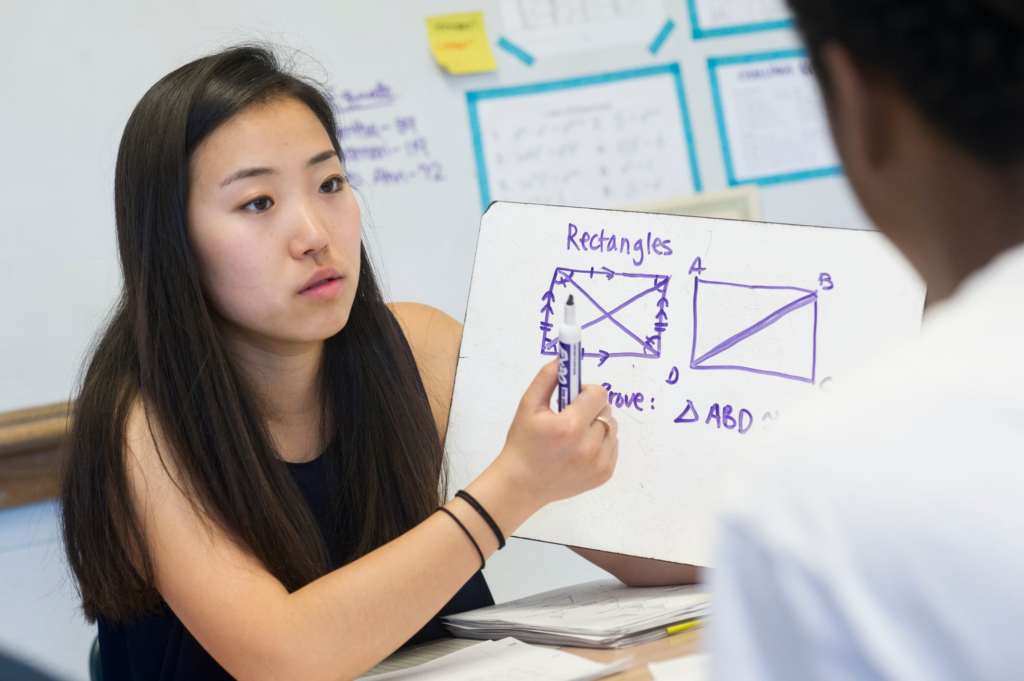Saga Education provides hands-on consulting to develop and implement Level 1 ESSA-rated evidence-based high-impact tutoring programs. When every student has access to a relationship that helps them see their potential, every student can achieve it.
The Future of Tutoring After COVID-19: Empowering Districts to Implement High-Impact Tutoring
During his State of the Union address this year, President Joe Biden acknowledged the devastating effect of unfinished learning on the nation’s K-12 students. He urged Americans to help by serving as tutors. His broader education plan calls for high-impact, school-based tutoring programs that provide students personalized instruction from trained and supported tutors.
Research shows that high-dosage tutoring can significantly improve academic performance, retention, and graduation rates.
Some district leaders, eager to mitigate the impact of the pandemic on student learning, will heed the call by dedicating portions of their ESSER funds to tutoring programs. And with good reason—research shows that high-impact tutoring can significantly improve academic performance, retention, and graduation rates. In fact, one study found that the benefits extend beyond the course in which students receive tutoring, with failure rates in their other courses decreasing, as well.

The quickest way for districts to reap the benefits of the ESSER funds is to contract with outside providers, like the one led by Saga Education, to deliver evidence-based instruction to struggling learners. This will undoubtedly result in increased academic achievement—at the cost of tens of millions of dollars nationwide.
But what happens when the ESSER money runs out in 2025? Do the tutoring programs and the life-changing assistance they bring end with it? Unfortunately, the answer in many cases will be yes, since not all districts can sustain the expense of using an outside provider for tutoring services.
Educators could choose to see this looming funding cliff as a crisis. Instead, it’s an opportunity that allows district leaders to think differently about how they deliver tutoring to their students.
In a world beyond ESSER, the most sustainable and scalable strategy is for districts to train and coach tutors themselves.
That won’t be as simple as hiring dozens of tutors and immediately turning them loose with students. High-quality tutoring requires a clear, consistent path for training tutors and program leaders, especially the high-impact kind.
To be most impactful, high-impact tutoring must align with what’s happening in the student’s classroom.
Sadly, too many tutors don’t receive sufficient pre-service training or, more importantly, ongoing coaching embedded in the day-to day-job. Most tutoring initiatives treat professional development as an afterthought and fail to observe and evaluate their tutors. According to a January 2021 report from the Learning Policy Institute, “large, poorly trained, insufficiently compensated tutoring corps” are a waste of time and money that don’t “do enough to accelerate student learning.” It said the most impactful tutoring programs invest “in staff capacity building by providing quality training and ongoing support.”
To be most impactful, high-impact tutoring must align with what’s happening in the student’s classroom. It can’t happen without a cycle of training, coaching, and feedback for the tutors. Ongoing coaching involves tutors receiving consistent feedback from dedicated managers and real-time support with academic differentiation, all to reinforce ideas covered during training.
The bottom line is that districts can’t afford to launch large-scale tutoring initiatives without offering quality operational infrastructure and wraparound support for incoming tutors and tutoring providers. That’s why they should develop strategies and coaching for in-house tutors or find an evidence-based partner to start and manage their programs.
Every student should have an opportunity to work with a school-based tutor at least once or twice while in school—most notably in early literacy and algebra.
Districts don’t need to provide a tutor for every student in every grade. But every student should have an opportunity to work with a school-based tutor at least once or twice while they’re in school — most notably in early literacy and algebra.
Researchers are finding that tutoring, specifically high-impact tutoring performed in small groups of two to three students as part of the daily school day, is one of the most effective ways to accelerate learning and boost academic performance.
High-impact tutoring is one of the most impactful educational interventions available to districts; something backed up by reams of data and research. The time has come to invest in sustainable versions of these programs. There are millions of students waiting to discover their academic gifts.
